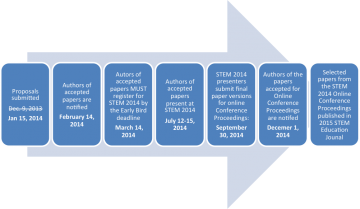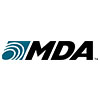The International Conference of STEM in Education is an opportunity for educators and researchers from schools, universities, colleges, businesses, industries and other private and public agencies to share and discuss their innovative practices and research initiatives that may advance STEM education.
We invite proposals from educators, academics, education officers, industry partners, graduate and undergraduate students for papers, poster presentations, panels, workshops, symposia, and innovative showcases. Proposals will be peer reviewed.
The Call for Papers is now closed.
The submission reviews are now complete, authors will be notified no later than Friday, February 28 of the final decision.
- Call for Papers Deadline:
December 9, 2013, extended to January 15, 2014 - Notification of Acceptance/Rejection: February 14, 2014
- All Authors must register before the early bird deadline:
March 1, 2014, extended to March 14, 2014 - Final Papers Deadline: September 30, 2014
- Conference Proceedings Published: December 1, 2014

You must create a use ID through the conference software in order to begin the submission process. You will be prompted to login/create a user ID to start the submission process, and ensure you select all three options for your account type: Reader, Author, Reviewer.
All submissions must be received in Microsoft Word or pdf file using the online submission system. All the documents must use Times New Roman font (11 or 12 point), 2-cm margins (all margins), with consecutive page numbering, as shown on the Paper Submission Template.
The online submission must be completed and submitted by December 9, 2013 (23.59 GMT) in order to be considered for the Conference. No late submissions will be considered.
There are three types of submissions for the Conference including:
- Papers and poster presentations
- Panels and symposia
- Innovative showcases and workshops.
All of the submissions can be either individual or co-authored.
Paper and Poster Submissions:
Proposals are a maximum of 3,000 words and must not exceed four (4) printed pages including tables and figures, and one (1) page of references. Paper presentation will not exceed 20 minutes (including five minutes for questions). Poster presentations will have a designated time allocation in the Program during which the authors of accepted contributions are expected to be present. References must be included on an additional single page. The proposal must include:
- Preferred designation for presentation format: Paper or poster
- Title (no more than 20 words)
- Authors and affiliations (including the corresponding author’s e-mail)
- Keywords
- Abstract (250 words maximum)
- Goals and objectives
- Theoretical framework
- Methodology
- Results and discussion (if the results are yet to come, it should be emphasized)
- Conclusions and significance of the study
- References (one page maximum)
Panel or Symposium Submission:
A panel or symposium offers opportunities to discuss or examine a particular STEM education inquiry problem or topic through multiple presenters and expert discussants (maximum of five members). Panel and symposium sessions will not exceed 90 minutes. A symposium or a panel organizer will be responsible for identifying a theme or an issue significant to the STEM field and bringing together the presenters who will be able to contribute. The organizer will assemble all the information and submit it. Proposals are a maximum of 4,000 words and must not exceed six (6) printed pages, and one (1) page of references. The submission must comprise the following elements:
- Preferred designation for presentation format: Panel or symposium
- Title (no more than 20 words)
- Names of the Chair and Panel or Symposium members and their affiliations (including the Chair’s e-mail)
- Keywords
- Abstract (250 words maximum)
- Proposed issues and themes for the Panel or Symposium and Rationale
- Goals and objectives
- Intended outcomes
- The expected contribution from each Panel or Symposium member
- References or other relevant information (one page maximum)
Innovative Showcase and Workshop Submissions:
Proposals are a maximum of 2,000 words and must not exceed three (3) printed pages including tables and figures. Workshop and showcases will have a two-hour time limit. The proposal must include:
- Preferred designation for presentation format: An Innovative showcase or a Workshop
- Title (no more than 20 words)
- Presenters and affiliations (including the corresponding author’s e-mail)
- Keywords
- Relevant online resources if available
- Proposed time allocation (maximum 2 hours)
- Abstract (200 words maximum)
- Goals and objectives
- Modes of audience engagement
- Maximum number of audience participants
- Special resources and requirements from the STEM 2014 organizers
- Relevance and significance to the STEM field and Conference audience
- Expected impact for STEM 2014 participants
All submissions are peer reviewed. Criteria include the quality of the proposal, the relevance to the Conference themes, significance of research questions or issues, appropriateness of the research methodology and analysis, the importance of the findings, and the overall logic and clarity of the conclusions and implications of the research. For Workshops and Innovative Showcase presentations, the audience engagement will be paramount. Relevance and significance to the STEM field and Conference audience, as well as expected impact for STEM 2014 participants will be given priority consideration.
All authors who submit a proposal for STEM 2014 Conference will be expected to serve as reviewers for other proposals.
Presenting authors of accepted papers AND all participants in accepted panels, symposia, workshops and innovative showcases are expected to attend and register for the STEM 2014 Conference before the Early Bird deadline on March 14, 2014.
All registered STEM participants will have access to the papers published in the STEM 2014 online proceedings. They will be available on the Presentations webpage page in December 2014.
Not all proposals accepted for presentation at the conference will be published. After the conference in July, we will post an announcement to all authors of the deadline to submit final papers (September 30, 2014). The committee will assess the quality of the papers to determine eligibility for publishing by December 1, 2014.















